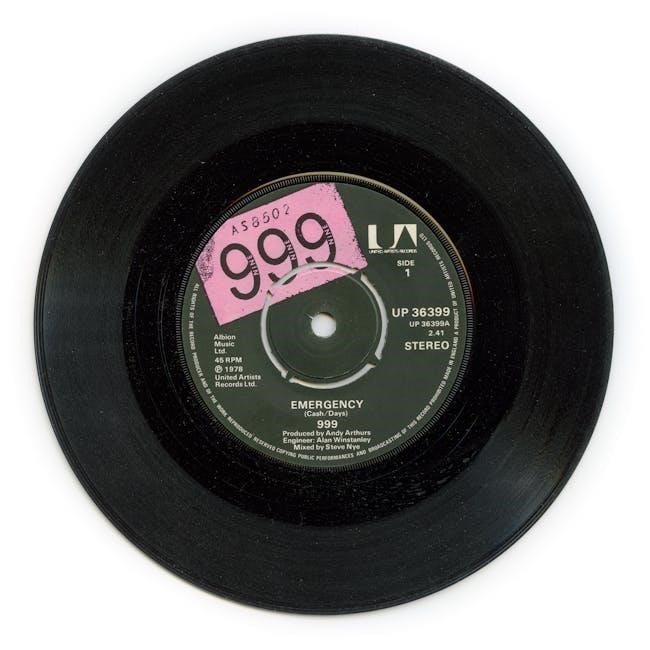The Goldmine Record Guide serves as a crucial tool for collectors and sellers navigating the world of vinyl records. It provides a standardized system for assessing the condition of records, ensuring transparency in the buying and selling process. This guide is widely used.
What is the Goldmine Grading System?
The Goldmine Grading System is a classification framework designed to evaluate the condition of vinyl records, offering a common language for collectors and sellers alike. This system is based on a scale that ranges from Mint (the highest grade) to Poor/Fair (the lowest), encompassing several intermediate levels that describe varying degrees of wear and damage.
The Goldmine system considers both the visual and audible aspects of a record, along with the condition of its sleeve and any accompanying inserts. A record’s grade reflects its overall presentation and playability, taking into account factors such as scratches, surface noise, and cover wear. Accurate grading is essential for establishing fair prices and ensuring customer satisfaction in the used record market.
The system’s widespread adoption has made it the industry standard, particularly on platforms like Discogs and eBay, where it helps buyers make informed purchasing decisions. By providing a consistent and reliable means of assessing record quality, the Goldmine Grading System plays a vital role in maintaining trust and transparency within the record collecting community. It is a critical component for anyone involved in buying, selling, or trading vinyl records.
History and Origin of the Goldmine Grading System
The Goldmine Grading System emerged in the early days of record collecting, born from the need for a standardized method to assess the condition of vinyl records. Inspired by grading systems used in other collecting fields, such as coins, books, comics, and cards, the Goldmine system sought to bring consistency and clarity to the burgeoning record market.
Developed by the Goldmine Record Magazine, a publication dedicated to record collecting, the system quickly gained traction and became the industry standard. Its widespread adoption was driven by its comprehensive approach, which considered both the visual and audible aspects of a record, as well as the condition of its packaging.
The Goldmine Grading System provided a framework for evaluating records ranging from pristine, unplayed copies to heavily worn items, allowing collectors and sellers to communicate effectively about the quality of their records. Over time, the system has been refined and adapted to meet the evolving needs of the record collecting community, solidifying its place as the most widely used grading system for vinyl records.
Its influence extends to online marketplaces like Discogs and eBay, where it continues to serve as the foundation for accurate and transparent record grading.

The Goldmine Grading Scale: An Overview
The Goldmine Grading Scale offers a detailed spectrum for evaluating vinyl record condition. Ranging from Mint to Poor, it considers both visual and audible aspects. This system is used by collectors and sellers for transparent transactions.
Mint (M) Condition
A Mint (M) record represents the pinnacle of condition, signifying absolute perfection. It’s essentially a brand-new item, never having been played or handled. Typically, a Mint record remains sealed, untouched from the moment it left the manufacturer. The vinyl surface gleams flawlessly, devoid of any blemishes, scratches, or imperfections.
The label is pristine, without spindle marks or signs of wear. The original packaging, including the cover, inner sleeve, and any inserts, mirrors this immaculate state. The cover is crisp, with sharp edges and vibrant colors, free from any ring wear, creases, or tears. All original inserts, such as lyric sheets or promotional materials, are present and in perfect condition.
In essence, a Mint record encapsulates the untouched quality of a newly manufactured item, making it a highly sought-after treasure for collectors. This grade assures the buyer that they are acquiring a record in its original, unblemished state, offering the closest experience to owning a brand-new release. The sound quality is expected to be flawless, free from any surface noise or distortion.
Near Mint (NM or M-) Condition
A Near Mint (NM) or Mint Minus (M-) record signifies exceptional condition, closely resembling Mint but with minor imperfections. It’s a record that has been handled with utmost care, possibly played a few times, but meticulously preserved. The vinyl retains its original gloss, exhibiting only the faintest signs of use, such as superficial paper scuffs from sliding in and out of the sleeve.
These blemishes are purely cosmetic and do not affect the listening experience. The label remains clean, with perhaps a barely visible spindle mark. The cover is in excellent shape, displaying minimal wear, such as slight corner dings or very light ring wear. It should be free of any significant creases, tears, or seam splits.
The original inner sleeve is present and in good condition. Overall, a Near Mint record offers an outstanding listening experience, with virtually no surface noise or distractions. It represents a record that has been cherished and well-maintained, making it a highly desirable addition to any collection. This grade is often considered the highest grade given by many dealers.
Very Good Plus (VG+) or Excellent (E) Condition
A Very Good Plus (VG+) or Excellent (E) record represents a well-cared-for item that exhibits some signs of use but remains in overall great condition. The vinyl may display light surface scratches or scuffs, but these should not significantly impact the listening experience. Expect minimal surface noise, if any, that doesn’t overpower the music. The record label might have some minor imperfections, such as light spindle marks or slight discoloration.
The cover typically shows noticeable wear, including ring wear, edge wear, and minor creases. However, there should be no major flaws like seam splits or tears. The original inner sleeve might be present but could have some wear and tear. A VG+ or Excellent record offers a satisfying listening experience with only minor distractions.
It’s a record that has been enjoyed but still retains much of its original appeal. Collectors often seek out VG+ records as a balance between affordability and quality. This grade is a step below Near Mint but still represents a respectable addition to any collection. Accurate grading is key here;
Very Good (VG) Condition
A Very Good (VG) record shows more obvious signs of wear and handling than a VG+ copy. Expect to see surface scratches and scuffs that are more prominent and may cause some audible surface noise, such as crackling or pops, particularly during quieter passages. However, the music should still be enjoyable, and the record should play through without skipping.
The record label may exhibit noticeable wear, including writing, stickers, or significant spindle marks. The cover will have more pronounced ring wear, edge wear, and creases. Seam splits may be present, but they should not be extensive. The cover may also have some discoloration or staining.
While a VG record is not in pristine condition, it can still be a worthwhile addition to a collection, especially for rare or desirable titles. Many collectors are willing to accept a VG copy as a placeholder until a better-condition version becomes available. The price of a VG record should reflect its condition.
Good (G) Condition
A record in Good (G) condition displays significant wear and is only suitable for filling a gap in a collection or for casual listening when a better copy is unavailable. Expect considerable surface noise, including prominent crackling, pops, and possibly even distortion, especially in quieter sections and during loud passages. The record may have numerous scratches, scuffs, and groove wear that are clearly visible.
The record label will likely have significant wear, such as heavy spindle marks, writing, stickers, or tears. The cover will exhibit substantial ring wear, edge wear, and seam splits that may be quite extensive. There may be tears, stains, or other damage to the cover. While a G-graded record is far from ideal, it can serve a purpose for collectors seeking a rare or hard-to-find item at a reduced price. The sound quality will be compromised, but the record should still be playable without skipping.

Importance of Accurate Grading
Accurate grading, as defined by the Goldmine standard, is paramount in the vinyl record market for both buyers and sellers. Precise grading establishes trust and transparency, fostering positive transactions and minimizing disputes. When sellers provide an honest assessment of a record’s condition, buyers can make informed decisions, knowing exactly what to expect in terms of sound quality and physical appearance.
Overgrading can lead to dissatisfied customers, negative feedback, and potential returns, ultimately damaging a seller’s reputation. Undergrading, while seemingly safer, can result in lost profits, as the record’s true value is not reflected in the asking price. Accurate grading ensures fair pricing, reflecting the record’s condition and rarity. It also protects collectors from unknowingly purchasing damaged or misrepresented items. By adhering to the Goldmine standard, the vinyl community promotes integrity and maintains the value of record collections. It is a cornerstone of ethical buying and selling.

Goldmine vs. Other Grading Systems
The Goldmine Grading System stands as a widely adopted standard in the vinyl record community, but it’s crucial to understand how it compares to other grading systems. While variations exist, the Goldmine system is valued for its detailed and descriptive approach, providing a comprehensive overview of a record’s condition.
Other systems, like the Record Collector grading system, may use similar terms but with slightly different interpretations. Some sellers might employ more subjective or simplified scales, making it essential for buyers to understand the specific criteria being used. Goldmine’s strength lies in its widespread recognition, making it easier to compare listings across different platforms. However, buyers should always clarify a seller’s grading practices, especially when dealing with unfamiliar systems. Understanding these differences ensures informed purchasing decisions and helps avoid discrepancies in expectations. The Goldmine system strives to be a clear and concise approach.

Using Goldmine for Buying and Selling Records
The Goldmine Grading System is invaluable for both buyers and sellers in the vinyl record market. For sellers, accurate grading based on Goldmine standards builds trust and ensures customer satisfaction. Conservative grading, where the record’s condition is slightly understated, can lead to pleasant surprises for buyers, fostering positive feedback and repeat business. Clear descriptions, referencing Goldmine terminology, minimize disputes and returns.
Buyers benefit from the Goldmine system by having a reliable framework for assessing a record’s condition before purchasing. This allows them to make informed decisions, comparing prices and conditions across different listings. Understanding the nuances of each grade, from Mint to Good, helps manage expectations and avoid disappointment. It’s always wise to ask for additional photos or details from sellers to confirm the grading, especially for higher-value records. When buying or selling, always keep the Goldmine grading system in mind. This is to help ensure smooth interactions.
The Goldmine Standard on Platforms like Discogs and eBay
The Goldmine Grading Standard is widely adopted on popular online platforms like Discogs and eBay, providing a common language for buyers and sellers. Discogs, in particular, explicitly uses the Goldmine Grading Guide to represent the condition of physical music in its marketplace. This standardization allows users to easily filter and compare records based on their graded condition, ensuring a more transparent and reliable buying experience.
While eBay doesn’t mandate the use of Goldmine, many sellers recognize its importance and incorporate it into their listings. However, consistency can vary, making it crucial for buyers to carefully review descriptions and request additional information or photos. It is very important to consider the Goldmine standard on platforms like Discogs and Ebay. This helps users to navigate the market effectively and confidently, facilitating fair transactions and preserving the integrity of the vinyl collecting community. Always do your research!